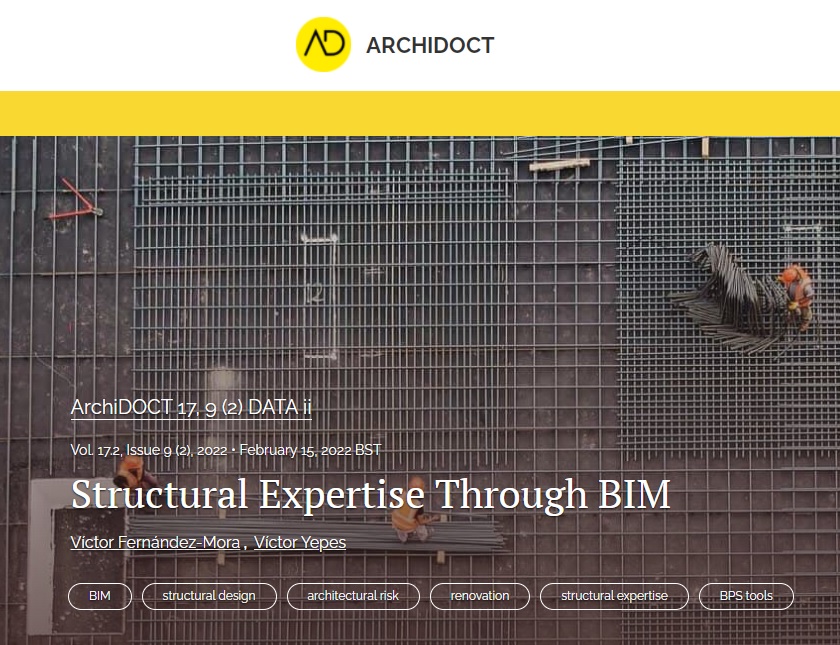 En este artículo continuamos la línea de investigación que está desarrollando nuestro grupo de investigación en relación con BIM. Se trata de un artículo que nos acaban de publicar en archiDOCT y que podéis encontrar también en este enlace.
En este artículo continuamos la línea de investigación que está desarrollando nuestro grupo de investigación en relación con BIM. Se trata de un artículo que nos acaban de publicar en archiDOCT y que podéis encontrar también en este enlace.
BIM (Building Information Modeling) es una tecnología líder en la Industria de la Arquitectura, Ingeniería y Construcción (Industria AEC). La mayoría de profesionales están adoptando esta tecnología en su día a día, mejorando sus capacidades. Otra gran tendencia en la industria AEC es la rehabilitación de edificios fuera de uso o antiguos y su adaptación a las nuevas demandas. Últimamente, la renovación y rehabilitación de edificios ha producido más ingresos que la construcción de nuevos edificios en el mercado inmobiliario español. El uso de BIM para los edificios existentes combina las capacidades de gestión de datos de BIM con las tendencias económicas del sector dando a los profesionales nuevas herramientas para adaptar esos edificios. El refuerzo estructural puede ser necesario durante las rehabilitaciones por lo que se suele realizar un peritaje estructural.
En este trabajo, hemos creado una herramienta vinculada a Autodesk Revit que puede extraer los datos necesarios del modelo BIM y realizar una prueba de peritaje a una viga de hormigón. Utilizando BIM para este fin, se pueden utilizar los datos almacenados para determinar la necesidad de refuerzo estructural y ofrecer al profesional más control sobre el proyecto. El uso de esos datos acorta los plazos y evita errores y descuidos en el diseño. Como el modelo de información del edificio es una base de datos rica en información, puede proporcionar los datos necesarios para garantizar el análisis. Se realiza un estudio de caso que muestra las capacidades de la herramienta. La investigación contribuye a integrar la rehabilitación estructural en los entornos BIM reduciendo la redundancia en el software y unificando tanto el almacenamiento como el análisis de datos a través de la metodología BIM.
ABSTRACT:
Building Information Modelling (BIM) is a leading technology in the Architecture, Engineering and Construction Industry (AEC Industry) and nowadays is being adopted for most professionals and improving its capabilities. There is another big trend in the AEC Industries, the rehabilitation of unused or old buildings and its adaptation to the new demands. Lately, building renovation and rehabilitation have produced more income than the construction of new buildings in the Spanish housing market. The use of BIM for existing buildings combines the BIM data management abilities with the economic trends in the industry giving the professionals new tools to adapt those buildings. Structural reinforcement may be needed during the rehabilitations so structural expertise is usually performed. In this paper, we have created a tool linked to Autodesk Revit that can extract the necessary data from the BIM model and perform an expertise test through a concrete beam. By using BIM for this purpose, we can use the data stored in the BIM model to determine the necessity or not of structural reinforcement and give the professional more control over the project. The use of that stored data shortens the working time for the professional and avoids errors and oversights in the design. Since the building information model is a rich information database it can provide the necessary data to ensure the analysis. A case study is performed showing the capabilities of the tool. The research contributes to integrating structural rehabilitation into the BIM environments reducing the redundancy in software and unifying both, data storage and data analysis via the BIM methodology.
Keywords:
BIM; structural design; architectural risk; renovation; structural expertise; BPS tools.
Referencia:
FERNÁNDEZ-MORA, V.; YEPES, V. (2022). Structural Expertise Through BIM. ArchiDOCT, Vol.17.2, Issue 9(2).
